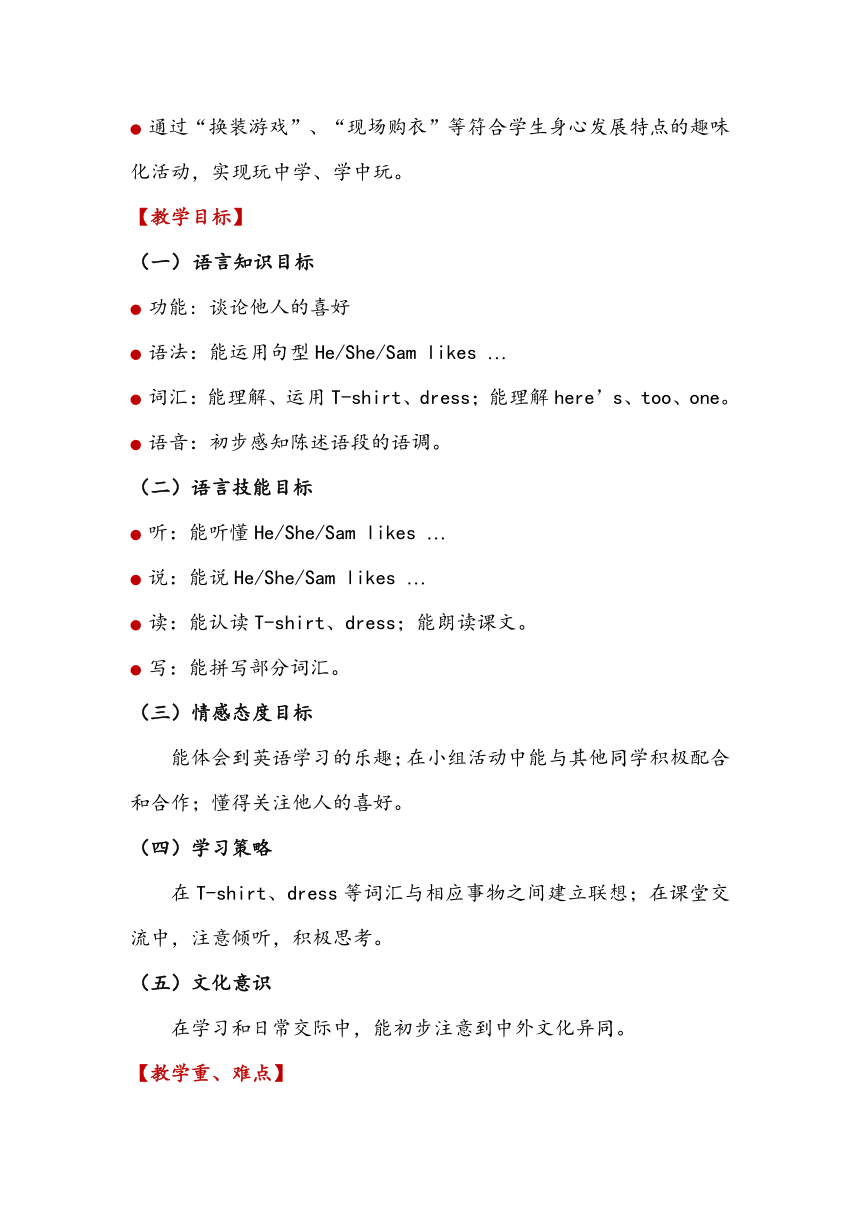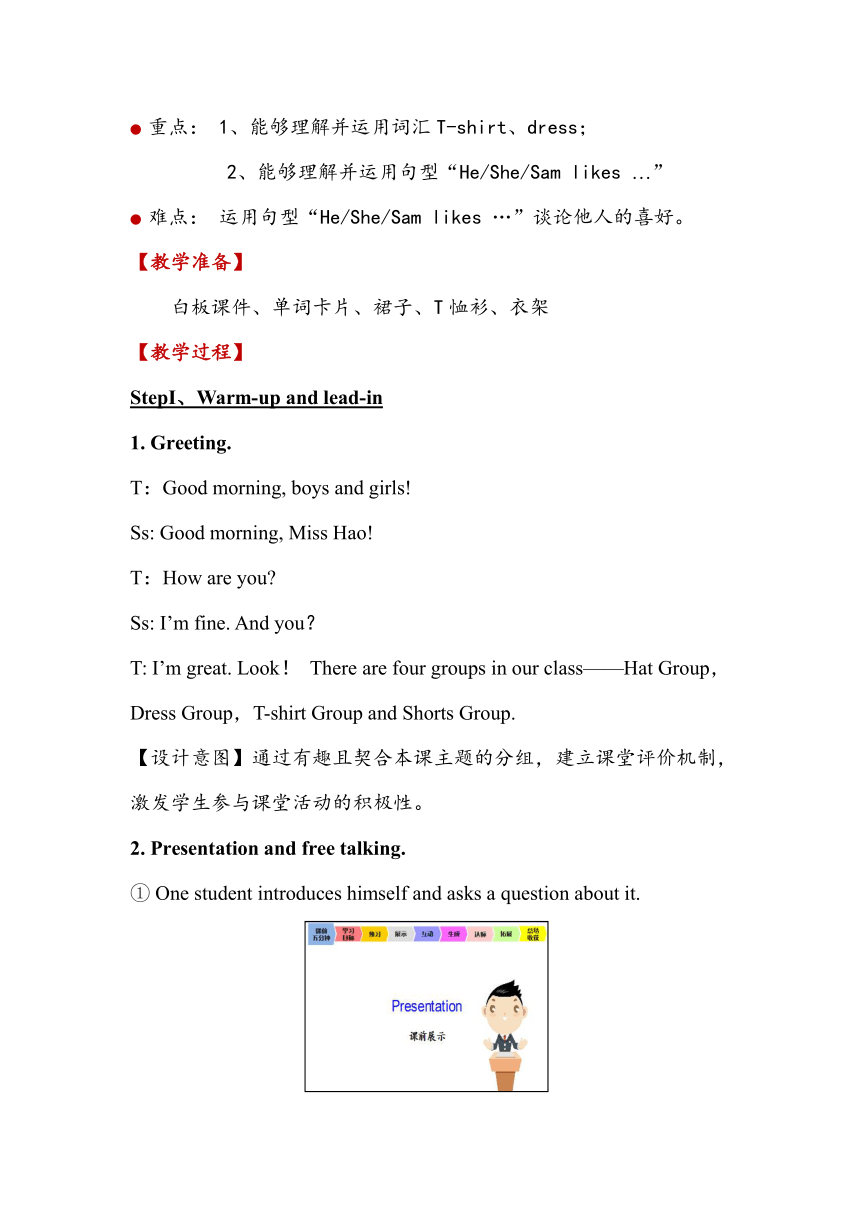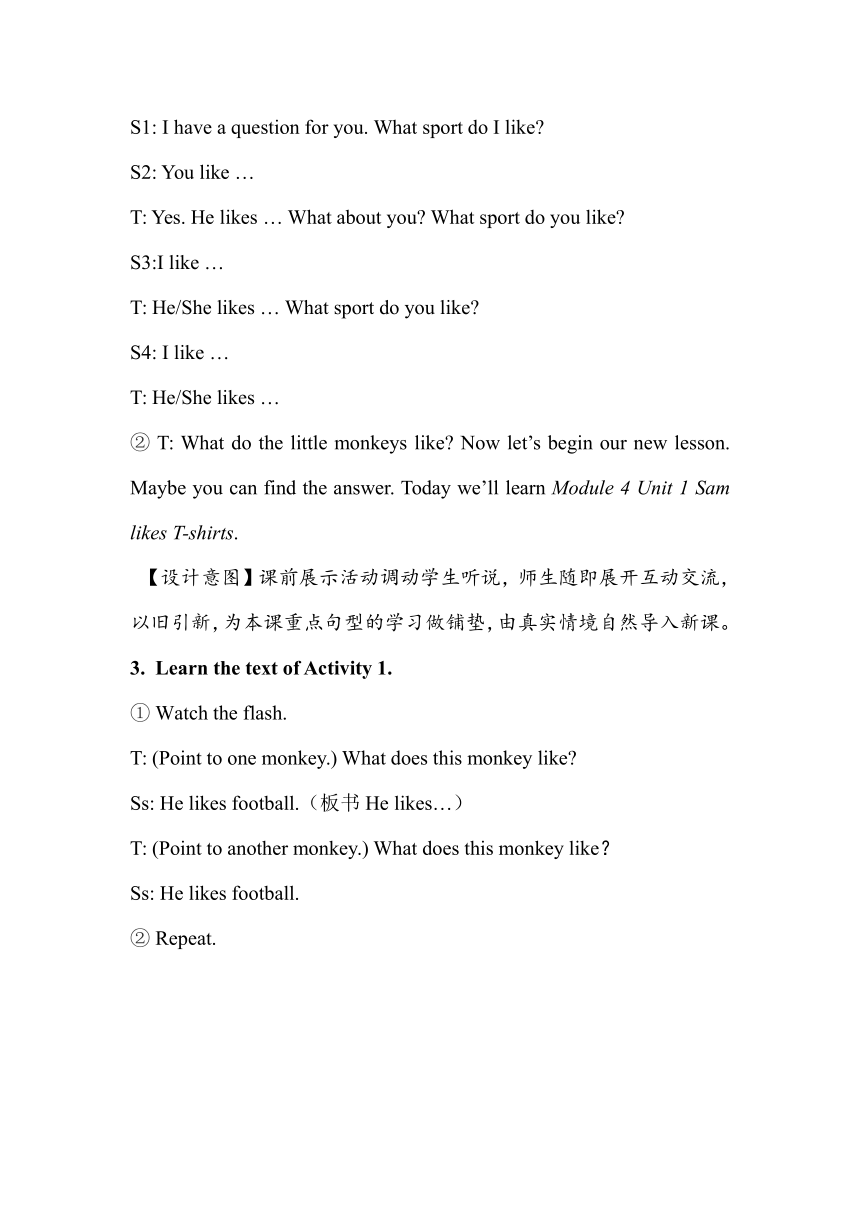Module4 Unit 1 Sam likes T-shirts.教案(含设计意图)
文档属性
| 名称 | Module4 Unit 1 Sam likes T-shirts.教案(含设计意图) |  | |
| 格式 | doc | ||
| 文件大小 | 640.5KB | ||
| 资源类型 | 教案 | ||
| 版本资源 | 外研版(一年级起点) | ||
| 科目 | 英语 | ||
| 更新时间 | 2021-09-26 09:21:23 | ||
图片预览





文档简介
新标准英语(一起)二年级上册
Module
4
Unit
1
Sam
likes
T-shirts.
教学设计
【教材分析】
本节课是《新标准英语》一年级起点二年级上册Module
4
Unit
1
Sam
likes
T-shirts.是一节以衣服为话题,以表述他人的喜好为功能的新授课。课文通过Sam和Amy随爸爸妈妈在商场买衣服的对话展开,Amy和Sam后来分别选择了自己喜欢的裙子和T恤衫。本课是学生初次学习实意动词一般现在时第三人称单数结构,具有一定难度。
【学情分析】
二年级的学生活泼好动,在已有的语言基础知识和基本技能之上,愿意参与语言学习活动,基于此,教师在课堂上要采取有效提问的方式,展开趣味化的教学活动,启发学生的思维,生成语言,发展学生的综合语言运用能力。
【设计理念】
●
在教学中,注重语言学习和操练活动的环环相扣、层层深入,使学生在问题引导和自主合作探究中逐步生成、习得语言,培养学生的语言思维。
●
充分利用交互式电子白板的互动性和生成性功能辅助教学,使信息技术与课程有效融合,打造高效课堂。
●
通过“换装游戏”、“现场购衣”等符合学生身心发展特点的趣味化活动,实现玩中学、学中玩。
【教学目标】
(1)
语言知识目标
●
功能:
谈论他人的喜好
●
语法:能运用句型He/She/Sam
likes
…
●
词汇:能理解、运用T-shirt、dress;能理解here’s、too、one。
●
语音:初步感知陈述语段的语调。
(二)语言技能目标
●
听:能听懂He/She/Sam
likes
…
●
说:能说He/She/Sam
likes
…
●
读:能认读T-shirt、dress;能朗读课文。
●
写:能拼写部分词汇。
(三)情感态度目标
能体会到英语学习的乐趣;在小组活动中能与其他同学积极配合和合作;懂得关注他人的喜好。
(四)学习策略
在T-shirt、dress等词汇与相应事物之间建立联想;在课堂交流中,注意倾听,积极思考。
(五)文化意识
在学习和日常交际中,能初步注意到中外文化异同。
【教学重、难点】
●
重点:
1、能够理解并运用词汇T-shirt、dress;
2、能够理解并运用句型“He/She/Sam
likes
…”
●
难点:
运用句型“He/She/Sam
likes
…”谈论他人的喜好。
【教学准备】
白板课件、单词卡片、裙子、T恤衫、衣架
【教学过程】
StepⅠ、Warm-up
and
lead-in
1.
Greeting.
T:Good
morning,
boys
and
girls!
Ss:
Good
morning,
Miss
Hao!
T:How
are
you?
Ss:
I’m
fine.
And
you?
T:
I’m
great.
Look!
There
are
four
groups
in
our
class——Hat
Group,Dress
Group,T-shirt
Group
and
Shorts
Group.
【设计意图】通过有趣且契合本课主题的分组,建立课堂评价机制,激发学生参与课堂活动的积极性。
2.
Presentation
and
free
talking.
①
One
student
introduces
himself
and
asks
a
question
about
it.
S1:
I
have
a
question
for
you.
What
sport
do
I
like?
S2:
You
like
…
T:
Yes.
He
likes
…
What
about
you?
What
sport
do
you
like?
S3:I
like
…
T:
He/She
likes
…
What
sport
do
you
like?
S4:
I
like
…
T:
He/She
likes
…
②
T:
What
do
the
little
monkeys
like?
Now
let’s
begin
our
new
lesson.
Maybe
you
can
find
the
answer.
Today
we’ll
learn
Module
4
Unit
1
Sam
likes
T-shirts.
【设计意图】课前展示活动调动学生听说,师生随即展开互动交流,以旧引新,为本课重点句型的学习做铺垫,由真实情境自然导入新课。
3.
Learn
the
text
of
Activity
1.
①
Watch
the
flash.
T:
(Point
to
one
monkey.)
What
does
this
monkey
like?
Ss:
He
likes
football.(板书He
likes…)
T:
(Point
to
another
monkey.)
What
does
this
monkey
like?
Ss:
He
likes
football.
②
Repeat.
③(用白板的渐变功能将like、likes变成心形)Read
together.
④
Read
by
yourselves.
【设计意图】通过活动一小韵律体验动词like的变化。心形图案形象地代表了like的含义,使学生在局部文本图示化的情况下加深对目标语言的感知。
StepⅡ、Presentation
1.
Look
and
say.
T:
(Show
a
picture
of
Activity
2.)
Who
are
they?
Where
are
they?
2.
Listen
and
learn
the
new
words.
Watch
the
flash.
Choose
clothes
for
Sam
and
Amy.
(学生运用白板的拖拽功能完成)
T:
(Show
a
shirt.)
What’s
this?
Ss:
It’s
a
shirt.
T:
(Show
a
T-shirt.)
Is
it
a
shirt?
Ss:
No,
it
isn’t.
T:
(用白板的渐变功能将T恤演变为字母T,再变回)
This
is
a
T-shirt.
(板书T-shirt)
(Show
two
T-shirts.)What
are
they?
Ss:
They
are
T-shirts.
(板书变为T-shirts)
One
group
read
“T-shirt,
T-shirts”
one
by
one.
T:
(Show
a
dress.)
Look,
what’s
this?
Ss:
It’s
a
dress.
T:
Yes,
It’s
a
dress.(板书dress)
(Show
two
dresses.)
And
what
are
they?
Ss:
They
are
dresses.
(板书变为dresses)
One
group
read
“dress,
dresses”
one
by
one.
T:
(With
a
dress
in
the
hand.)
Here’s
a
dress.(板书here’s)
“Here’s”
is
the
same
with?
Ss:
“Here
is”.
T:
XXX,
come
here!
Here’s
a
dress
for
you!
Do
you
like
it?
(With
a
super
big
dress
in
the
hand.)
S5:
No!
It’s
big!
T:
Yes,
it’s
too
big!
(板书too)
What
about
this
one?
Ss:
It’s
too
small.
T:
This
one
is
too
big,
and
this
one
is
too
small.
(板书one)
【设计意图】学生初步感知课文,并训练学生在听力中获取信息的能力;结合语境、白板功能、实物,以及在词汇之间建立联系帮助学生直观生动地理解和学习词汇。突破教学重点1。
3.
Listen
and
think.
①Listen,
point
and
circle
“likes”.(一名学生在白板上圈画示范)
②Discuss
the
sentences
in
groups.
Try
to
find
the
rules.
(预设:当主语是he/she或人名时要将like变为likes。完善板书)
【设计意图】通过圈画活动引起学生对like的第三人称单数形式的有意注意,进而在情境中理解带有likes的语句;学生小组合作探究文本,生成本课重点句型。
4.
Listen
and
repeat.
T:
What
does
Amy
like?
Ss:
Amy
likes
dresses.
T:
What
does
Sam
like?
Ss:
Sam
likes
T-shirts.
T:
But
Amy
can
only
choose
one
dress.
(用白板的拖拽功能演示艾米喜欢其中的一条裙子,
引导学生理解重点句型)
So
we
can
say
...
Ss:Amy
likes
this
dress.
T:
Sam
can
only
choose
one
T-shirt.
Ss:
Sam
likes
this
T-shirt.
【设计意图】在感知、体验、生成后,借助图片演示加深学生对重点词句的理解。将文本内容的理解与句型的理解和运用相结合,突破教学重点2。
5.
Read
in
groups.
【设计意图】再次整体理解课文,内化重点词汇与句型的运用;团队合作,互相帮助,矫正语音语调,体验合作中的成就感。
Step
Ⅲ、Practice
and
consolidation
1.
Read
the
words.
(服装视力表)
T:
Maybe
you're
tired
now.
Let’s
relax
and
check
the
“eyesight”.
One
student
points,
the
others
read.
【设计意图】在新颖又贴近生活的小活动设计中,训练学生对表示衣服的名词及其复数形式(易错点)的识词、认读能力。
2.
Listen,
say
and
match.(换装游戏)
T:
There
are
so
many
clothes
here.
Let’s
choose
clothes
for
the
children.
Students
say
the
sentences
and
match
the
clothes
with
the
cartoon
children.
(学生运用白板的拖拽功能完成)
【设计意图】操练本课重点词汇和句型,训练学生的听说能力;将操练活动设计成学生熟悉的游戏形式,大大增加学生学习语言、运用语言的兴趣,实现玩中学、学中玩。
3.
Do
and
say.
(现场购衣)
T:
The
children
are
very
happy.
Do
you
want
to
choose
some
clothes,
too?
You
can
choose
clothes
for
your
partners.
Students
ask
their
partners’
ideas
and
choose
clothes
for
them.
(情感渗透:在为他人选购物品时,要首先了解对方的喜好和想法才能选到合适的物品。同时,别人帮助你后你一定要说“谢谢”。)
【设计意图】在真实情境中运用语言,体现英语学习的工具性,提升学生的综合语言运用能力;使学生了解到要了解他人的喜好,落实情感目标。这一环节突破本课教学难点。
Step
Ⅳ、Extension
Think.
I
like
football.
→
He
likes
football.”
I
play
football.
→
He
?
football.”
【设计意图】举一反三,探究动词的第三人称单数的用法,提升学生的自主认知能力。
Step
V、Summary
1.
Students
sum
up
what
they
learnt
today.
2.
The
teacher
sums
up
the
groups’
performance.
【设计意图】学生自主总结收获,锻炼总结归纳能力,建构知识体系;通过小组评价总结激发学生的进取心和小组合作意识,提升英语学习内驱力。
板书设计:
Module
4
Unit
1
Sam
likes
T-shirts.
He
T-shirts
She
likes
...
dresses
Amy
here’s
too
教学评价设计:
以小组为单位进行教学评
价,激发学生参与课堂活动的
积极性,提升学生的团队意识。
小组命名契合本课主题,且生
动可爱,符合学生心理特点。
PAGE
Module
4
Unit
1
Sam
likes
T-shirts.
教学设计
【教材分析】
本节课是《新标准英语》一年级起点二年级上册Module
4
Unit
1
Sam
likes
T-shirts.是一节以衣服为话题,以表述他人的喜好为功能的新授课。课文通过Sam和Amy随爸爸妈妈在商场买衣服的对话展开,Amy和Sam后来分别选择了自己喜欢的裙子和T恤衫。本课是学生初次学习实意动词一般现在时第三人称单数结构,具有一定难度。
【学情分析】
二年级的学生活泼好动,在已有的语言基础知识和基本技能之上,愿意参与语言学习活动,基于此,教师在课堂上要采取有效提问的方式,展开趣味化的教学活动,启发学生的思维,生成语言,发展学生的综合语言运用能力。
【设计理念】
●
在教学中,注重语言学习和操练活动的环环相扣、层层深入,使学生在问题引导和自主合作探究中逐步生成、习得语言,培养学生的语言思维。
●
充分利用交互式电子白板的互动性和生成性功能辅助教学,使信息技术与课程有效融合,打造高效课堂。
●
通过“换装游戏”、“现场购衣”等符合学生身心发展特点的趣味化活动,实现玩中学、学中玩。
【教学目标】
(1)
语言知识目标
●
功能:
谈论他人的喜好
●
语法:能运用句型He/She/Sam
likes
…
●
词汇:能理解、运用T-shirt、dress;能理解here’s、too、one。
●
语音:初步感知陈述语段的语调。
(二)语言技能目标
●
听:能听懂He/She/Sam
likes
…
●
说:能说He/She/Sam
likes
…
●
读:能认读T-shirt、dress;能朗读课文。
●
写:能拼写部分词汇。
(三)情感态度目标
能体会到英语学习的乐趣;在小组活动中能与其他同学积极配合和合作;懂得关注他人的喜好。
(四)学习策略
在T-shirt、dress等词汇与相应事物之间建立联想;在课堂交流中,注意倾听,积极思考。
(五)文化意识
在学习和日常交际中,能初步注意到中外文化异同。
【教学重、难点】
●
重点:
1、能够理解并运用词汇T-shirt、dress;
2、能够理解并运用句型“He/She/Sam
likes
…”
●
难点:
运用句型“He/She/Sam
likes
…”谈论他人的喜好。
【教学准备】
白板课件、单词卡片、裙子、T恤衫、衣架
【教学过程】
StepⅠ、Warm-up
and
lead-in
1.
Greeting.
T:Good
morning,
boys
and
girls!
Ss:
Good
morning,
Miss
Hao!
T:How
are
you?
Ss:
I’m
fine.
And
you?
T:
I’m
great.
Look!
There
are
four
groups
in
our
class——Hat
Group,Dress
Group,T-shirt
Group
and
Shorts
Group.
【设计意图】通过有趣且契合本课主题的分组,建立课堂评价机制,激发学生参与课堂活动的积极性。
2.
Presentation
and
free
talking.
①
One
student
introduces
himself
and
asks
a
question
about
it.
S1:
I
have
a
question
for
you.
What
sport
do
I
like?
S2:
You
like
…
T:
Yes.
He
likes
…
What
about
you?
What
sport
do
you
like?
S3:I
like
…
T:
He/She
likes
…
What
sport
do
you
like?
S4:
I
like
…
T:
He/She
likes
…
②
T:
What
do
the
little
monkeys
like?
Now
let’s
begin
our
new
lesson.
Maybe
you
can
find
the
answer.
Today
we’ll
learn
Module
4
Unit
1
Sam
likes
T-shirts.
【设计意图】课前展示活动调动学生听说,师生随即展开互动交流,以旧引新,为本课重点句型的学习做铺垫,由真实情境自然导入新课。
3.
Learn
the
text
of
Activity
1.
①
Watch
the
flash.
T:
(Point
to
one
monkey.)
What
does
this
monkey
like?
Ss:
He
likes
football.(板书He
likes…)
T:
(Point
to
another
monkey.)
What
does
this
monkey
like?
Ss:
He
likes
football.
②
Repeat.
③(用白板的渐变功能将like、likes变成心形)Read
together.
④
Read
by
yourselves.
【设计意图】通过活动一小韵律体验动词like的变化。心形图案形象地代表了like的含义,使学生在局部文本图示化的情况下加深对目标语言的感知。
StepⅡ、Presentation
1.
Look
and
say.
T:
(Show
a
picture
of
Activity
2.)
Who
are
they?
Where
are
they?
2.
Listen
and
learn
the
new
words.
Watch
the
flash.
Choose
clothes
for
Sam
and
Amy.
(学生运用白板的拖拽功能完成)
T:
(Show
a
shirt.)
What’s
this?
Ss:
It’s
a
shirt.
T:
(Show
a
T-shirt.)
Is
it
a
shirt?
Ss:
No,
it
isn’t.
T:
(用白板的渐变功能将T恤演变为字母T,再变回)
This
is
a
T-shirt.
(板书T-shirt)
(Show
two
T-shirts.)What
are
they?
Ss:
They
are
T-shirts.
(板书变为T-shirts)
One
group
read
“T-shirt,
T-shirts”
one
by
one.
T:
(Show
a
dress.)
Look,
what’s
this?
Ss:
It’s
a
dress.
T:
Yes,
It’s
a
dress.(板书dress)
(Show
two
dresses.)
And
what
are
they?
Ss:
They
are
dresses.
(板书变为dresses)
One
group
read
“dress,
dresses”
one
by
one.
T:
(With
a
dress
in
the
hand.)
Here’s
a
dress.(板书here’s)
“Here’s”
is
the
same
with?
Ss:
“Here
is”.
T:
XXX,
come
here!
Here’s
a
dress
for
you!
Do
you
like
it?
(With
a
super
big
dress
in
the
hand.)
S5:
No!
It’s
big!
T:
Yes,
it’s
too
big!
(板书too)
What
about
this
one?
Ss:
It’s
too
small.
T:
This
one
is
too
big,
and
this
one
is
too
small.
(板书one)
【设计意图】学生初步感知课文,并训练学生在听力中获取信息的能力;结合语境、白板功能、实物,以及在词汇之间建立联系帮助学生直观生动地理解和学习词汇。突破教学重点1。
3.
Listen
and
think.
①Listen,
point
and
circle
“likes”.(一名学生在白板上圈画示范)
②Discuss
the
sentences
in
groups.
Try
to
find
the
rules.
(预设:当主语是he/she或人名时要将like变为likes。完善板书)
【设计意图】通过圈画活动引起学生对like的第三人称单数形式的有意注意,进而在情境中理解带有likes的语句;学生小组合作探究文本,生成本课重点句型。
4.
Listen
and
repeat.
T:
What
does
Amy
like?
Ss:
Amy
likes
dresses.
T:
What
does
Sam
like?
Ss:
Sam
likes
T-shirts.
T:
But
Amy
can
only
choose
one
dress.
(用白板的拖拽功能演示艾米喜欢其中的一条裙子,
引导学生理解重点句型)
So
we
can
say
...
Ss:Amy
likes
this
dress.
T:
Sam
can
only
choose
one
T-shirt.
Ss:
Sam
likes
this
T-shirt.
【设计意图】在感知、体验、生成后,借助图片演示加深学生对重点词句的理解。将文本内容的理解与句型的理解和运用相结合,突破教学重点2。
5.
Read
in
groups.
【设计意图】再次整体理解课文,内化重点词汇与句型的运用;团队合作,互相帮助,矫正语音语调,体验合作中的成就感。
Step
Ⅲ、Practice
and
consolidation
1.
Read
the
words.
(服装视力表)
T:
Maybe
you're
tired
now.
Let’s
relax
and
check
the
“eyesight”.
One
student
points,
the
others
read.
【设计意图】在新颖又贴近生活的小活动设计中,训练学生对表示衣服的名词及其复数形式(易错点)的识词、认读能力。
2.
Listen,
say
and
match.(换装游戏)
T:
There
are
so
many
clothes
here.
Let’s
choose
clothes
for
the
children.
Students
say
the
sentences
and
match
the
clothes
with
the
cartoon
children.
(学生运用白板的拖拽功能完成)
【设计意图】操练本课重点词汇和句型,训练学生的听说能力;将操练活动设计成学生熟悉的游戏形式,大大增加学生学习语言、运用语言的兴趣,实现玩中学、学中玩。
3.
Do
and
say.
(现场购衣)
T:
The
children
are
very
happy.
Do
you
want
to
choose
some
clothes,
too?
You
can
choose
clothes
for
your
partners.
Students
ask
their
partners’
ideas
and
choose
clothes
for
them.
(情感渗透:在为他人选购物品时,要首先了解对方的喜好和想法才能选到合适的物品。同时,别人帮助你后你一定要说“谢谢”。)
【设计意图】在真实情境中运用语言,体现英语学习的工具性,提升学生的综合语言运用能力;使学生了解到要了解他人的喜好,落实情感目标。这一环节突破本课教学难点。
Step
Ⅳ、Extension
Think.
I
like
football.
→
He
likes
football.”
I
play
football.
→
He
?
football.”
【设计意图】举一反三,探究动词的第三人称单数的用法,提升学生的自主认知能力。
Step
V、Summary
1.
Students
sum
up
what
they
learnt
today.
2.
The
teacher
sums
up
the
groups’
performance.
【设计意图】学生自主总结收获,锻炼总结归纳能力,建构知识体系;通过小组评价总结激发学生的进取心和小组合作意识,提升英语学习内驱力。
板书设计:
Module
4
Unit
1
Sam
likes
T-shirts.
He
T-shirts
She
likes
...
dresses
Amy
here’s
too
教学评价设计:
以小组为单位进行教学评
价,激发学生参与课堂活动的
积极性,提升学生的团队意识。
小组命名契合本课主题,且生
动可爱,符合学生心理特点。
PAGE
同课章节目录
- Module 1
- Unit 2 I like football
- Unit 1 I like the ABC song.
- Module 2
- Unit 1 I don't like meat
- Unit 2 I don't like ginger.
- Module 3
- Unit 1 Do you like bananas?
- Unit 2 Do they like apples?
- Module 4
- Unit 1 Sam likes T-shirts.
- Unit 2 He doesn't like these trousers
- Module 5
- Unit 1 At 7,I get up.
- Unit 2 I go home at 5.
- Module 6
- Unit 1 What do you do on Sundays?
- Unit 2 Where do you live?
- Module 7
- Unit 1 How do you go to school?
- Unit 2 I go by train.
- Module 8
- Unit 1 She goes swimming.
- Unit 2 Does he play the piano?
- Module 9
- Unit 1 It's winter.
- Unit 2 What does he do in summer?
- Module 10
- Unit 1 Happy New Year!
- Unit 2 We have Christmas.
- Review Module
- unit 1
- unit 2
